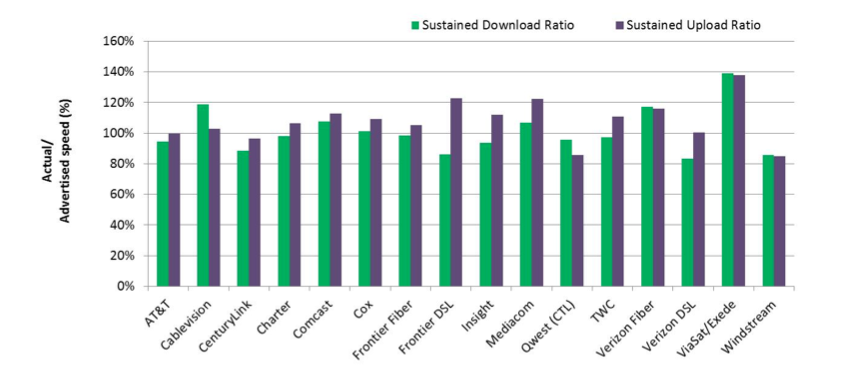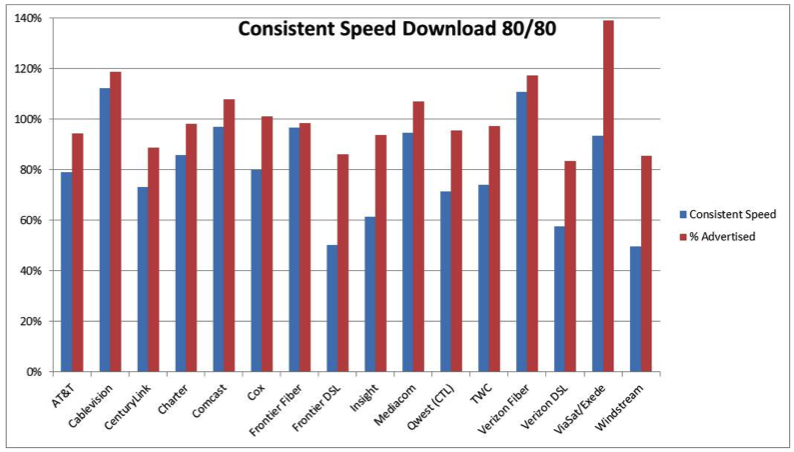ISPs Are Mostly Delivering The Speeds They Advertise, Just Not Consistently
 What does it mean when a cable company advertises “blazing fast Internet” or download speeds “up to 15 Mbps”? Does that mean all the time for everyone, or just an average? And how far from those “up to” speeds can an Internet service provider be before they have some explaining to do?
What does it mean when a cable company advertises “blazing fast Internet” or download speeds “up to 15 Mbps”? Does that mean all the time for everyone, or just an average? And how far from those “up to” speeds can an Internet service provider be before they have some explaining to do?
The FCC has released its latest Measuring Broadband America report for 2014, which looks at the actual speeds that American consumers are getting from the nation’s largest ISPs and how those stack up against what those ISPs are promising.
The good news: For the first time in the four years that the FCC has been doing this report, ISPs as a whole are delivering the speeds they promise… on average.
As the chart at the top shows, some ISPs are doing better than others. For example, Verizon FiOS, Comcast, and Cablevision are each delivering sustained uploads and download speeds that meet or exceed the advertised rates. Others, mostly DSL providers are still not able to deliver the speeds they promise. But even the worst provider in the study, Windstream, is still coming in above 80% of its advertised speeds.
But the FCC’s first look at the consistency of these speeds shows some cracks in the system.

This chart can be a little confusing. The standard for consistency set by the FCC for this metric was whether 80% of an ISP’s customers get the full advertised speed 80% of the time. So while Cablevision, Comcast, Cox, Mediacom, FiOS, and ViaSat/Exede all delivered sustained speeds that are above the advertised levels, only Cablevision and FiOS are consistently delivering the promised speeds. Meanwhile, many of the DSL providers — Frontier, Verizon, Windstream — are far from consistent in delivering advertised speeds.
FCC Chair Tom Wheeler has directed the commission to reach out to ISPs that are providing slower than advertised and/or highly inconsistent speeds to find out what these companies are doing to resolve these discrepancies.
“Consumers deserve to get what they pay for,” said Wheeler in a statement. “While it’s encouraging to see that in the past these reports have encouraged providers to improve their services, I’m concerned that some providers are failing to deliver consistent speeds to consumers that are commensurate to their advertised speeds.”
With regard to the hot-button topic of interconnection — the points at which commercial bandwidth providers dump off their data to ISPs to carry the last mile to consumers — and the congestion of interconnection points, the FCC didn’t include any data on that.
The report states that it has historically not counted statistics for data over degraded interconnection points because that had usually just been a correctable network error as opposed to something systemic.
However recent spats between ISPs like Verizon, Comcast, and AT&T and Netflix’s bandwidth providers have affected a large number of people and the FCC recognizes that “consumers accessing services and content over the affected paths would likely see a significant degradation in their service.”
And so the report does not include measurements from degraded interconnection points, but the FCC has collected test results from impacted servers and is releasing this information for others to pick apart.
Chairman Wheeler recently directed his staff to investigate this type of congestion and has obtained details on the deals Netflix made with Comcast and Verizon to pay for better access to their networks.
Want more consumer news? Visit our parent organization, Consumer Reports, for the latest on scams, recalls, and other consumer issues.

